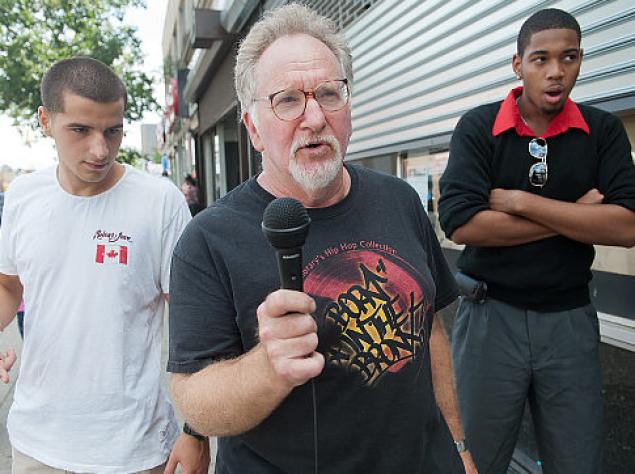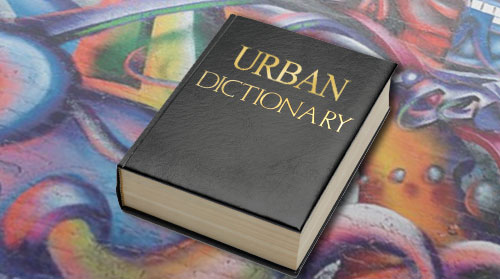
Among the many things I love about my job at Fordham University is that I get to deal with academics on a daily basis. Sometimes, I sit in on their classes. One of the most interesting professors is Mark Naison, professor of history and African American Studies.
For as long as I’ve been here, he’s taught a very popular, hard to get into (due to it filling up very quickly) class called, “From Rock & Roll to Hip Hop: Urban Youth Cultures in Post War America.” It’s a class where music is heard (the rock & roll and soul stuff is GREAT) and special guest musicians give performances and mini-lectures. It all makes me wish I was an undergrad!
You can read some media coverage of Dr. Naison’s class, as well as his alter-ego, “The Notorious Ph.D., below. (Yes, Dr. Naison is known to rap.)
Brooklyn, the Remix: A Hip-Hop Tour (via New York Times)
Morrisania Melody (via New York Times)
Notorious Ph.D., aka Fordham Professor Mark Naison, raps against gentrification in the Bronx (via Daily News)
Meet the Notorious Ph.D.: Mark Naison (via Gothamist)
Check out the syllabus for the Fall 2013 semester here (bold emphasis mine):
AFAM 3134
From Rock and Roll to Hip Hop: Urban Youth Cultures in Post War America
Dr. Mark Naison
Course Description:
Since the late 19th Century African Americans have exerted a powerful influence on the development of American popular music. Forms of musical expression developed in African-American communities have been reinterpreted and marketed to create the modern music industry, shaping the development of Tin Pan Alley, the Broadway musical stage, the record industry, the modern dance band, and music radio.
Until the end of World War II, racism and lack of capital kept African-American artists and entrepreneurs on the margins of this activity, denying them access to commercial venues that would reward them for their creativity and create a national audience base outside the black community. Only a handful of Black artists -Louis Armstrong, Duke Ellington, Cab Calloway, Billie Holliday, Ella Fitzgerald, Marian Anderson, Paul Robeson- had large enough followings outside the “race market”- the section of the music industry targeted to blacks- to make them truly national figures In post World War II era, however, the terms of this cultural interchange began to shift. Civil rights victories, north and south, black migration to urban areas, and the opening of new economic opportunities in industry and government employment set the stage for a new relationship between blacks and the music industry. As radio stations in major cities began to tap into the growing African-American market, black music of all types-gospel blues, swing, rhythm and blues- began to hit the airwaves.
The newest of these genres, rhythm and blues, a urban music that fused sweet harmonies and powerful dance beats, sparked a musical and commercial revolution by attracting a huge underground audience among whites. By the early 1950’s, “black” music radio from Memphis to Los Angeles was attracting hundreds of thousands of white listeners, most of them under the age of twenty five, and sparking an unexpected growth of record sales for artists who had only aimed for the “race market.” In several cities, white disc jockeys decided to tap into this new youth audience by incorporating rhythm and blues into their formats and got such a huge response that they made it the centerpiece of their shows.
Calling it “rock and roll,” they marketed it as youth music rather than black music and looked for white artists who could play it to supplement the already established black stars. This marketing strategy was brilliantly successful. By the early sixties, rock and roll had become the musical language of a generation of American youth, crossing racial and cultural barriers that had never previously been bridged by the music industry.
Though white entrepreneurs and artists made the bulk of the profits in this billion dollar business, scores of black artists cracked into national markets that had previously been closed to them and shaped the musical tastes of millions of young whites. Chuck Berry, Little Richard, the Drifters, the Shirelles, the Coasters, Lloyd Price, Fats Domino, Sam Cooke, Ray Charles, to name a few, were central to the early success of rock and roll, and their influence would later be built on by Motown artists like the Supremes, the Four Tops and the Temptations, and soul singers like James Brown, Otis Redding and Aretha Franklin. The terms of cultural interchange in this music were shaped by the site of its creation; the post-war metropolis. Rock and roll was the product of a long economic boom that brought blacks into the center of the industrial economy and placed them in close proximity with the descendants of white and latino immigrants. On street corners and in school gymnasiums, in clubs and theaters, in radio stations and recording studious, African-American artists and entrepreneurs mingled with musicians, producers and songwriters of other nationalities.
In the earliest days of rock and roll, the sources of creativity flowed upward from city streets, but as the music became more popular, the recording industry was taken over by media conglomerates, removing its experimental, grass roots atmosphere and separating it from its African-American roots. By the late 1960’s and 1970’s rock and roll had become typecast as “white” music, identified more with its white suburban following than its African-American originators; while African-American artists moved into niches in the music market where a modified urban sensibility still prevailed- funk, disco, soul, and pop. However, African-American and Latino youths, trapped in decaying neighborhoods savaged by disinvestment and government neglect, found themselves disfranchised by these musical developments.
In post-industrial cities where vacant lots, shuttered factories, and decaying schools marked the boundaries of crushed hopes and declining opportunities, young blacks and Latinos, supported by a small number of adventurous whites, invented a new music that fused verbal improvisation, scratching and back beats and fragments of previous musical genres into a jarring, densely rhythmic, compulsively danceable mix. Played in community centers and schoolyards, house parties and small clubs, the music initially attracted little interest from recording companies or commercial radio. But its extraordinary popularity among urban youth soon caught the attention of neighborhood promoters, who began recording the music, and hip audiences in the largely white downtown “punk” scene.
By the early 80’s, hip hop or rap, had started to crack into mass markets and commercial radio, even though most established professionals didn’t regard it as real music. But the music accurately expressed the sensibility of people who had been left out post-industrial social order or who were rebelling against its mores. Hip hop, despite fierce skepticism and opposition, not only survived, but exploded becoming the most commercially successful musical form in the world by the mid-90’s, defining not only the sensibility of urban youth in the United States, but young people of various backgrounds all over the world. Once again African-American cultural creativity, forged in an urban setting, had redefined the musical tastes of a generation.
In the course that follows, we will examine how the sensibility and musical creativity of urban youth, in two very different historical periods , inspired musical revolutions which transformed the tastes of entire generations, crossing boundaries of race, gender, nation and social class. How could this happen twice in fifty years? What does this say about the racial/cultural dynamics of post-war American society? About the connection between African-American culture and American culture? About race and gender dynamics in the culture industry? About the role of women in musical forms which emphasize an insurgent, eroticized masculinity and turn women into objects of desire and/or contempt? About how rebellion can be marketed, coopted and turned into an instrument for material gain?
To get at these questions, the course will use music, film, and literature as well as historical writings on the music industry and contemporary urban life. To add depth to our portrait, we will also explore musical countercultures of international derivation particularly punk, reggae, salsa and reggaeton, and look at how folk music and jazz periodically invade and occasionally shape popular musical forms. We will also explore how these musical forms become internationalized and how they are being brought to life today in new ways in nations around the world.
We have a graduate assistant working with the class, Melissa Castillo Garsow, who will give a few lectures and presentations on the globalization of hip hop. At various points in the class, people involved in the creation of the music we are studying will come to class to perform or talk about their work. There will also be an opportunity for students in the class to perform their music, inside or outside of class. We draw no line between musical creativity and musical analysis. Both are welcome in our classroom.
Required Readings:
Rebee Garafolo and Steve Waksman Rockin Out: Popular Music in the USA
Peter Guralnick Sweet Soul Music
Alice Echols The Scars of Sweet Paradise: The Life and Times of Janis Joplin
Nelson George Hip Hop America
Murray Foreman and Mark Anthony Neal That’s The Joint
Jay Z Decoded
Course Outline:
I. An Overview of Popular Music in the US: Garafalo and Waksman Rockin Out, Introduction
2. Some Antecedents of Rock and Roll: Garafalo and Waksman, Rockin Out, chapters 1 and 2, Rock and Roll, Race, and the invention of the “Teenager:” Garafalo and Waksman, Rockin Out, chapters 3-5 Echols, Scars of Sweet Paradise, chapter 1
3. Soundtrack to Social Revolution, Soul Music, Civil Rights and the Rise of the Counter Culture: Guralnick, Sweet Soul Music, 1, 3, 4, 5, 7, 10, 11 Echols, Scars of Sweet Paradise, 2-7 Garafalo and Waksman, Rockin Out, chapter 6
4. Black Power, White Flight and the Resegregation of Popular Music: Guralnick, Sweet Soul Music, ch. 12 Echols, Scars of Sweet Paradise, 8-9 Garafalo and Waksman, Rockin Out, Chapter 7, Mid-Term Examination
5. The Rise of Hip Hop: Creativity and Destruction in the Post-Industrial City: George, Hip Hop America, chapters 1-2, Foreman and Neal, That’s The Joint, selections Mark Naison “The Morrisania Roots of Hip Hop Culture” (article sent on internet) Mark Naison “From Doo Wop To Hip Hop” (article sent on internet)
6.. Caribbean and Latin Influences in Hip Hop Culture: Foreman and Neal, That’s The Joint, selections, Class Presentations/Lectures by Melissa Castillo-Garsow
7. Images of Rebellion: MTV, Music Videos, and Commercialization of Rap: Garafalo and Waksman, Rockin Out, chapters 8, 10 George, Hip Hop America, chapters 3-4, Foreman and Neal, That’s The Joint, selections
8. The Crack Epidemic and the Rise of Gangsta Rap: George, Hip Hop America, chs. 5-10 Foreman and Neal, That’s The Joint, 11, 17, 26, `44, Jay Z Decoded
9. Hip Hop Wars: Gender, Sexuality and the Politics of Contemporary Rap: George, Hip Hop America, chs. 11-18 Foreman and Neal, That’s The Joint, selections
10. The Globalization of Hip Hop: Foreman and Neal, That’s The Joint, selections, Class Presentations/Lectures by Melissa Castillo Garsow

